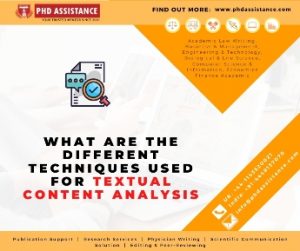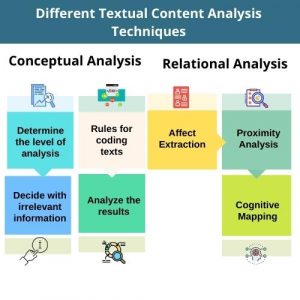What are the different techniques used for Textual Content Analysis
In Brief:
- Textual Analysis- Qualitative Research Analytics Help data analysis method to carefully inspects either the content and meaning of texts or their structure.
- The main objective is to analyses the presence of chosen term present inside the data that may be implicit (which are difficult to find) or explicit (which are easy to identify).
- It Helps the Researcher quantify and analyze the meaning, relationship and presence of specific concepts and themes.

Introduction:
Content analysis Tools are used to identify words, concepts or themes which are present inside the qualitative data. It also helps to convert identical and valid suggestions by coding textual material and analyzing textual or qualitative Analysis. This technique is used frequently in many research studies, but it becomes popular among scholars in the current time. It helps the researcher quantify and analyze the meaning, relationship and presence of specific concepts and themes. It is a language evaluating tool by the researcher for analyzing research
Conceptual Analysis
Data Analysis Textual Qualitative Content Analysis and conceptual Analysis are almost similar to each other. In a conceptual analysis, a particular concept is selected for Analysis which includes quantifying and calculating its presence. The main objective is to analyses the presence of chosen term present inside the data that may be implicit (which are difficult to find) or explicit (which are easy to identify). Encoding of implicit terms is more complicated. You need to consider or decide on the level of implicit terms by making judgments on its subjectivity, i.e., problem-related to reliability and validity. Therefore, implicit term coding needs dictionary or translational rules or both. PhD Qualitative Research Analysis Help in getting data which are often subjective, in-depth and consistent, if you find any difficulty with Textual or qualitative Analysis, you can get help from experts.
Necessary steps need to follow while coding a conceptual analysis
- Determine the research question and select a sample or samples for Analysis.
- After that code the text into manageable content groups, this is also known as a selective reduction process. By reducing the text into different groups helps the researcher to focus on the code or pattern for specific words that inform the research question.

General steps for conducting PhD Research Methods for Textual Data and conceptual content analysis:
- Determine the level of Analysis, whether it is for word, sentence, phrase, themes
- Select the number of concepts to code for: Create a pre-defined or interactive set of classes or theories.
Choose any one them A or B, which allow flexibility to the coding process. And stick with that pre-defined set of categories.
- Option A allows for Analysis and introduction of important content which could have significant implications to the research question.
- Option B allows the researcher to focus on the data for specific materials.
- Determine how to differentiate among different concepts:
- Determine whether the text needs to be coded in the same way they are or they need to be in an indifferent form, for example, “dangerous” as “dangerousness”. These rules make all the works to fall into the same category or maybe the rules can be expressed so that the researcher can differentiate these word sections into discrete codes.
- Decide on the level of implication to be allowed?
- Develop guidelines to code your text. The Researcher can Develop rules to translate text into codes, which will keep the process reliable or organized. The author can code what they want to code. Effectiveness of the coding process is guaranteed when the researcher is intelligible and dependable in their codes, meaning they are following their translation rules. Obeying translation rules is equal to validity in content analysis.
- Determine what needs to be done with irrelevant information: That has to be eliminated, for example, eliminating common English words like “the” and “and”.
- Code the text: It can be done with software which can be done automatically, quickly and defectively. If coding is done manually, there will be changes of getting error in the data, but if the coding is done manually, the text could be cleaned of error and misspelling. This choice of hand vs computer coding is most applicable for implicit material where category preparation is vital for precise coding.
- Analyze your results: Decide precisely regarding irrelevant or unwanted text to ignore or reconsider the coding scheme. Draw conclusions and simplifications where possible.
Relational Analysis
It begins like a conceptual analysis their concept is chosen for study; here, the relation between the concepts are examined. Independent concepts are explored as having no structural meaning, and relatively the idea is to create the relationships among ideas.
Necessary steps need to follow while coding a conceptual analysis
- Qualitative Text Analysis helps in identify the research problem and select a sample or samples for examination. The research questions must be attentive, so the conception types are not open to Analysis and summarized.
- Carefully select the content for Analysis; always choose enough information to conduct a thorough analysis. The results are not limited by having too general information so that the coding process becomes too difficult and dense to convey meaningful and significant results.
The relational Analysis is classified into three subcategories from primary to going down to the general step.
Affect extraction:
A problem in this method is that emotions can differ over time, population and space. But it effectively captures the emotional and psychological nature of the speaker or author of the text.
Proximity analysis:
Text is defined as a sequence of words known as “window” skimmed for the co-occurrence of concepts. The outcome will be the “concept matrix” or a group of interlinked co-occurring concepts that would recommend an overall meaning.
Cognitive mapping:
It helps to create a model representing the overall meaning of the text like a graphic map, and it used to describe the relationships between concepts.
Conclusion
Although content analysis tool is widely used to Analyze Text and Qualitative Data, many Researchers are not familiar with content analysis techniques and how to handle problems inherited in that application. The issues include identifying sufficient measures, creating proxy dictionaries and coding schemes, operating with texts from numerous sources, confirming reliability and validity, and guiding manual versus computer-aided content analysis.
Reference
- Mayring, P. (2004). Qualitative content analysis. A companion to qualitative research, 1(2004), 159-176.
- Carley, K. (1993). Coding choices for textual Analysis: A comparison of content analysis and map analysis. Sociological methodology, 75-126.
- Stemler, S. E. (2015). Content analysis. Emerging trends in the social and behavioral sciences: An Interdisciplinary, Searchable, and Linkable Resource, 1-14.
 Previous Post
Previous Post
